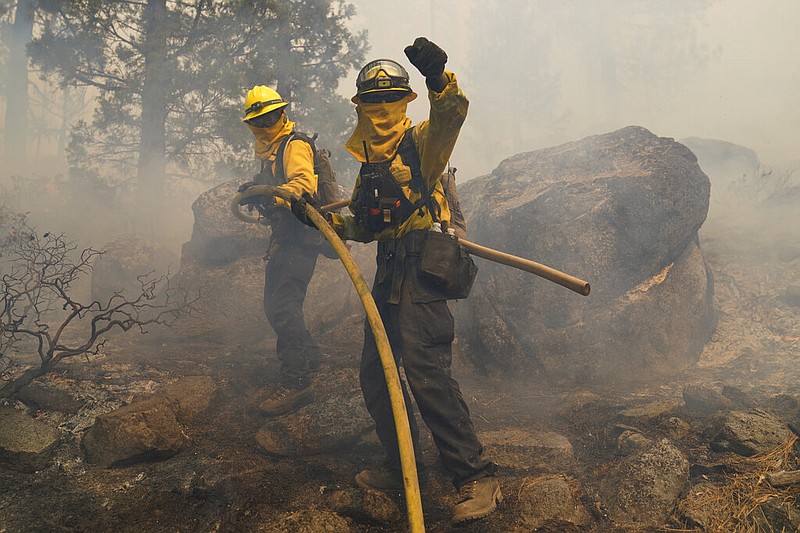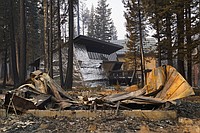SOUTH LAKE TAHOE, Calif. -- President Joe Biden declared an emergency in California that will allow federal assistance for the Caldor Fire, which has burned hundreds of structures and continues moving toward Nevada.
The fire fueled by heavy winds has barreled toward Lake Tahoe for several days. But that threat became one of many as the fire moved in other directions, including north toward Wrights Lake and Desolation Wilderness, and south toward Kirkwood.
Officials say it remains highly dangerous and thousands of weary firefighters are battling it on several fronts.
Red-flag conditions were expected to abate Thursday, according to incident meteorologist Jim Dudley. However, dry conditions and low humidity will remain persistent problems.
Biden's declaration allows for federal agencies to provide relief measures in areas hit hard by the fires.
The fire roared to more than 200,000 acres Wednesday but stayed mostly clear of the resort town as crews scrambled to keep it east of Pioneer Trail. Firefighters also managed to protect many of the homes in Christmas Valley and Meyers, both within the Tahoe Basin.
By Thursday morning, it had reached 210,259 acres and was 25% contained.
Officials confirmed some damage on the outskirts of the Sierra-at-Tahoe ski resort late Wednesday, according to Assistant Chief Jamie Moore, a Los Angeles firefighter working as part of the state's interagency effort on the Caldor Fire
"They did lose some outbuildings, but the main lodge was not damaged," Moore said.
Active structure defense is ongoing in Twin Bridges and Strawberry.
[Gallery not loading above? Click here for more photos » arkansasonline.com/93caldor/]
As of Thursday morning, 622 homes and 12 commercial properties had been destroyed by the fire, officials said. More than 32,000 structures remained threatened. Tens of thousands of people had been forced from their homes.
Among the evacuees at the Reno-Sparks Convention Center on Thursday was Paul Brooks, 64, of Roseville.
Brooks said he left his home near Sacramento because of wildfire smoke and rented a hotel room in South Lake Tahoe, where he figured the air was cleaner. Four days later, he was forced to evacuate.
Inside the convention center, he said he's seen people break down. Some get frustrated because they want to return home.
"But they can't because of the situation," he said. "People are becoming stir crazy, so I try to keep a positive attitude."
The fire's eastern flank remains a top concern, even with a reduction in wind conditions, according to officials.
"This is where we have a lot of focus," said Beale Monday, a spokesman with the California Department of Forestry and Fire Protection. "All of our resource focus on this side is all broken up into structure protection, and trying to skirt that fire away from the valuables at risk and the communities down here."
Monday said crews were laying bulldozer lines on the east side of Pioneer Trail and on the west side of Truckee Drive in an effort to keep flames away from South Lake Tahoe. Crews were also removing brush and debris from the side of the highways in the event that they have to ignite a backfire, he said.
Officials were considering opportunities to build a "catcher's mitt" beyond the immediate fire lines and into Nevada to stop the fire's march east, he said.
At Heavenly ski resort straddling the state border, containment lines made with bulldozers appeared to be keeping the fire at bay. On the northern side of the wildfire, however, flames remained active near the picturesque Desolation Wilderness and Wrights Lake.
To the south, plumes of smoke rose behind Kirkwood Mountain ski resort as officials used snow spreaders to wet down the area. Fire engines were parked throughout the community, poised to defend dozens of homes as well as resort property.
As of Wednesday night, the fire was about 5 miles from the state line, Moore said.
"I'd be surprised if it doesn't make it to Nevada in the next day or so," said Craig Clements, a professor of meteorology and director of the Wildfire Interdisciplinary Research Center at San Jose State University.
Clements' team used dynamic computer modeling to forecast the fire's likely behavior. The model initially showed the fire reaching Nevada late Wednesday night or early Thursday, he said, but was later amended to reflect slowing spread.

